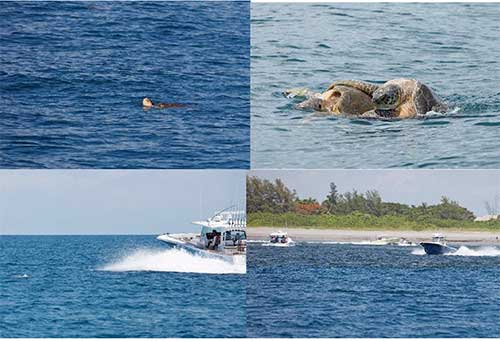Grant: 22-009R
Project Title: Information to Protect Florida's Most Valuable and Vulnerable Sea Turtles From Vessel Strikes: Year-Two Surveys And Statewide Hot-Spot Identification
Project Manager: Blair Witherington
Organization: Inwater Research Group (Non-Profit Organization)
Grant Amount: $22,198.25
Completion Date: 2022-11-24
Summary: Vessel-strike mortality in Florida's sea turtles presents population-level effects and is the most frequent, identifiable cause of death in strandings. This mortality is high in adults near high-density nesting beaches. This project is for the second year of a two-year effort to survey strike-vulnerable turtles off Florida's highest density nesting beaches. The project goal is to produce information that would change human behavior to reduce sea turtle boat strikes. The Year-Two adds necessary statistical power to Year-One surveys, which sampled 181 individual turtles on transects representing 887 km2 between central Brevard County and Palm Beach Inlet. As in Year One, Year-Two surveys will transect 23, 5-km, shore-perpendicular lines between Palm Beach Inlet and central Brevard County. Surveys will take place twice in May and twice in June, using a specialized research vessel with a sighting tower. We will use Distance Sampling analyses modeling environmental covariates to make turtle density estimates from transect data, and use the density estimates to generate distribution 'heat maps' using Density Surface Modeling. We will use FWC Statewide and Index Nesting Beach data, combined with our distance sampling estimates, to predict in-water turtle densities elsewhere in Florida. We will form our data output products to be most useful to the assignment of sea turtle protection zones and to illustrate the relative hazard of boat strikes for sea turtles. Results: This report describes data collection and analyses from a two-year project, which began in the 2021 nesting season and includes the current, 2022 reporting period. In 2022, we measured sea turtle abundance during eight days of nearshore surveys: four consecutive days in May and four consecutive days in June 2022. The surveys comprised 23, 5-km, shore-perpendicular transects between West Palm Inlet and approximately 20 kilometers north of Sebastian Inlet. Strong winds and heavy seas originally hampered our efforts to survey in May. We originally tried to survey on May 23rd but had to turn around after being unable to complete one survey due to discrepancies between the forecast and the actual conditions. Fortunately, we were able to restart the project later in that week at the end of May. In 2022, we observed 171 individual turtles at or near the surface. These turtles comprised 85 Loggerheads (16 adult females, 56 sex-unidentified adults, 13 sub-adults) and 86 Green Turtles (20 adult females, 22 adult males, 38 sex unidentified adults, 6 juveniles). In comparison in 2021, we observed 183 individual turtles at or near the surface. These turtles comprised 76 Loggerheads (16 adult females, 2 adult males, 58 sex-unidentified adults, 9 sub-adults), 95 Green Turtles (24 adult females, 21 adult males, 42 sex unidentified adults, 8 juveniles and 2 Leatherbacks (1 adult female, 1 sex-unidentified adult) Additional data included GPS position, side of vessel, perpendicular distance from transect, depth below surface (surface, 1-m depth, or deeper), behavior and association with other turtles (e.g., mating, guarding, courting). With additional data from a second year of this project, we were able to find a connection between the surface density of turtles vulnerable to boat strikes and adjacent nesting beach density. The best fit connection for this sits at a resolution of around 20 km. This finding is important, as this is a metric that can potentially be used throughout the state, finding the
connection between nesting beach density and nearshore density of turtles vulnerable to boat strike. Our recommendations are to continue these surveys in other regions with important nesting (e.g., SW Florida) to determine whether the model we tested applies to areas such as
Florida's Gulf coast.
Results: This report describes data collection and analyses from a two-year project, which began in the 2021 nesting season and includes the current, 2022 reporting period. In 2022, we measured sea turtle abundance during eight days of nearshore surveys: four consecutive days in May and four consecutive days in June 2022. The surveys comprised 23, 5-km, shore-perpendicular transects between West Palm Inlet and approximately 20 kilometers north of Sebastian Inlet. Strong winds and heavy seas originally hampered our efforts to survey in May. We originally tried to survey on May 23rd but had to turn around after being unable to complete one survey due to discrepancies between the forecast and the actual conditions. Fortunately, we were able to restart the project later in that week at the end of May. In 2022, we observed 171 individual turtles at or near the surface. These turtles comprised 85 Loggerheads (16 adult females, 56 sex-unidentified adults, 13 sub-adults) and 86 Green Turtles (20 adult females, 22 adult males, 38 sex unidentified adults, 6 juveniles). In comparison in 2021, we observed 183 individual turtles at or near the surface. These turtles comprised 76 Loggerheads (16 adult females, 2 adult males, 58 sex-unidentified adults, 9 sub-adults), 95 Green Turtles (24 adult females, 21 adult males, 42 sex unidentified adults, 8 juveniles and 2 Leatherbacks (1 adult female, 1 sex-unidentified adult) Additional data included GPS position, side of vessel, perpendicular distance from transect, depth below surface (surface, 1-m depth, or deeper), behavior and association with other turtles (e.g., mating, guarding, courting). With additional data from a second year of this project, we were able to find a connection between the surface density of turtles vulnerable to boat strikes and adjacent nesting beach density. The best fit connection for this sits at a resolution of around 20 km. This finding is important, as this is a metric that can potentially be used throughout the state, finding the
connection between nesting beach density and nearshore density of turtles vulnerable to boat strike. Our recommendations are to continue these surveys in other regions with important nesting (e.g., SW Florida) to determine whether the model we tested applies to areas such as
Florida's Gulf coast.